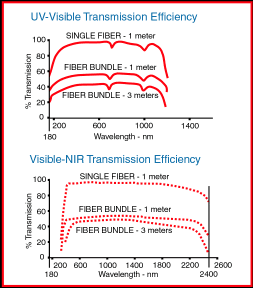
The
graphs above show the transmission characteristics for fiber
optic bundles and single fiber cables. The curves for the
bundles have included in the transmission the losses due to
packing factor, reflections at the entrance and exit, and the
losses within the fiber itself. Please contact us if you need a
more detailed explanation or to discuss your requirements.
See these links for individual fiber attenuation curves:
• UV SOLARIZATION
•
HIGH-POWER FIBER OPTICS |
Individual
Optical Fiber Bend Radius
Below is a table of the bend radius for a single fiber of the
core sizes listed. Fiber bundle and cable bend radius may be
further limited by sheath material, fiber quantity, and length.
FIBER CORE
SIZE
(µM) |
CONTINUOUS
BEND RADIUS
(mm) |
MOMENTARY
BEND RADIUS
(mm) |
|
50
100
200
400
600
1000
1500 |
 |
31
35
61
120
165
275
413 |
 |
12.5
14
25
48
66
110
165 |
 |
|
Optical Fiber
Acceptance Angle
The acceptance angle of an optical fiber
is dependent upon the refractive indices of its core and
cladding materials. The table below shows the acceptance angle
of the most common types of optical fiber:
FIBER TYPE
(CORE/CLAD) |
NUMERICAL
APERATURE |
FULL ACCEPTANCE
ANGLE |
F# |
|
|
SILICA/SILICA
|
0.12 |
13.8 |
4.2 |
|
SILICA/SILICA
|
0.22 |
25.4 |
2.3 |
|
SILICA/PLASTIC
|
0.39 |
46.0 |
1.3 |
|
SILICA/PLASTIC
|
0.48 |
57.4 |
1.0 |
|
BOROSILICATE GLASS
|
0.56 |
68.1 |
0.9 |
|
PLASTIC (PMMA)
|
0.55 |
66.7 |
0.9 |
|
|